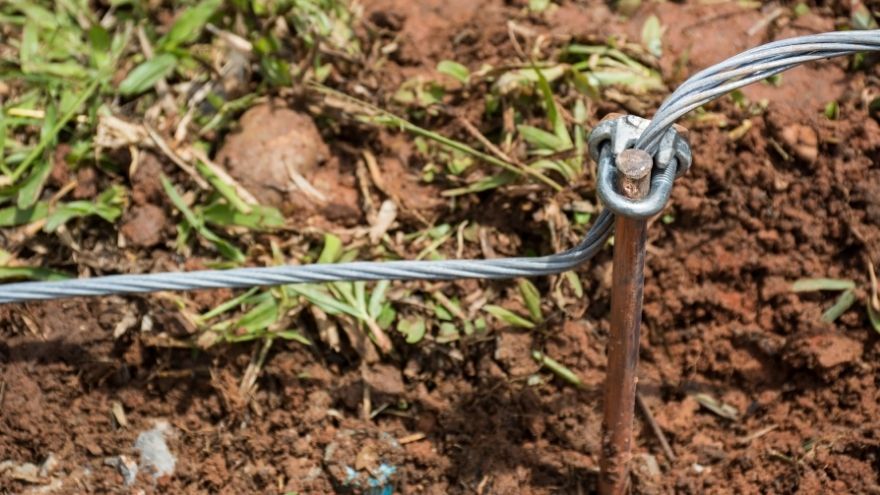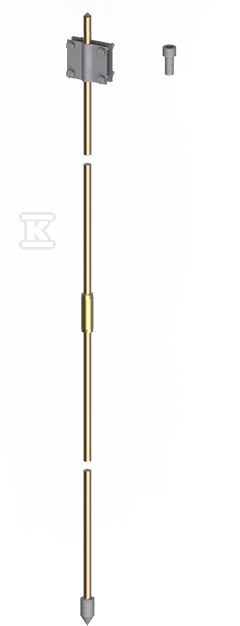Grounding pins are one of the most popular ways to perform effective grounding in power installations, both in homes and industrial facilities. It is a system that ensures the safety of the building by discharging current to the ground in the event of overvoltages, short circuits or lightning discharges. Check what grounding pins are, where they are used and how to properly install them to fulfill their function.

Check out the grounding pins at the Onninen wholesaler
What should the resistance level of a grounding pin be?
The value of the grounding resistance is a parameter that determines the effectiveness of the grounding . Too high a value of the grounding resistance can lead to overvoltages and damage to electrical devices, and even a threat to life. The importance of grounding is evidenced by the fact that without them, the lightning protection system practically does not work.
 A grounding pin is a type of vertical grounding installed directly in the ground. Grounding pins are used in electrical installations . They are also required by surge protection systems and lightning protection systems that protect electrical devices from the harmful effects of atmospheric discharges.
A grounding pin is a type of vertical grounding installed directly in the ground. Grounding pins are used in electrical installations . They are also required by surge protection systems and lightning protection systems that protect electrical devices from the harmful effects of atmospheric discharges.
A suitably low value of grounding resistance ensures that in the event of a fault, the installation will function correctly, protecting both the equipment and people nearby. Under the general insurance conditions, the grounding resistance value should not exceed 10 ohms .
Lightning protection systems require the grounding resistance value to be even lower, usually no more than 5 ohms. In addition, grounding should be made in a durable and safe manner . Connecting grounding wires to the ground requires the use of specialist connectors and materials.
What does the value of the grounding resistance depend on?
The value of the earthing resistance depends largely on the properties of the soil in which the earthing pin is placed. Moist and clay soils have lower resistivity than sandy soils, which makes the earthing more effective in such conditions.
The value of grounding resistance depends on several factors, including:
-
 Soil resistivity values : Soil resistivity is the property of the soil that determines its resistance to the flow of current in the ground. The lower the soil resistivity indicated by the measurement, the lower the value of the earth resistance;
Soil resistivity values : Soil resistivity is the property of the soil that determines its resistance to the flow of current in the ground. The lower the soil resistivity indicated by the measurement, the lower the value of the earth resistance; - Depths of earthing : The greater the layer of soil above the earth, the lower the value of the earthing resistance. The optimum depth is determined by measurements;
- Grounding Wire Lengths : The longer the grounding wires, the higher the grounding resistance value;
- Type of grounding : There are different types of grounding, e.g. pin grounding, foundation grounding, ring grounding. Each of them has a different value of grounding resistance. Let us add that grounding requires taking into account the length of each grounding measured from the base of the downconductor.
It is also worth paying attention to natural foundation earthing, which can be used as an additional supplement to the grounding system.
A foundation earth electrode is an installation in the form of a rod or strip embedded in the foundation. The combination of vertical earth electrodes and foundation earth electrodes can significantly reduce the value of the grounding resistance.
Correct determination of soil resistivity
The measurement of the ground resistivity is necessary to determine the required depth, distance for rod installation and type of grounding. It is most often recommended to perform periodic measurements carried out by a qualified specialist using appropriate equipment.
It is extremely important to correctly determine the soil resistivity value and match the length and number of earthing rods to the specific conditions at a given location. If the soil resistivity values are too high, it may be necessary to increase the number of earthing rods or their depth to achieve the desired parameters.
How deep should a grounding pin be installed?
The depth of the grounding pin depends on the ground resistivity.
![]() The depth to which the vertical grounding should be driven is at least 3 meters. The installation of a pin grounding rod consists of driving the appropriate number of rods into the ground. The grounding rod is driven to a depth at which the soil moisture is maintained at a constant level.
The depth to which the vertical grounding should be driven is at least 3 meters. The installation of a pin grounding rod consists of driving the appropriate number of rods into the ground. The grounding rod is driven to a depth at which the soil moisture is maintained at a constant level.
The most commonly used are:
- Vertical earth electrodes , which consist of metal rods driven into the ground;
- Foundation earthing , which can be used in newly constructed buildings as a grounding element built into the foundations.
The selection of the appropriate type of grounding depends on the specific ground conditions, building size and installation requirements.
Are you looking for effective and durable grounding rods and grounding conductors? Are you interested in efficient and safe lightning protection grounding rods ? Check out the Onninen wholesale offer today! Here you will find a full range of products necessary for effective grounding in all conditions.